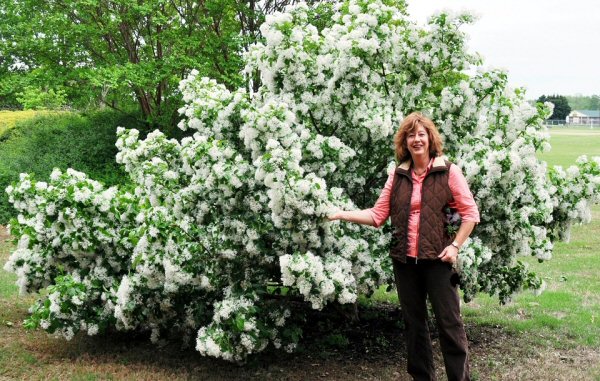May Plant of the Month: Chinese fringetree

Carol Reese, UT Extension horticulture specialist, shows off the “snowy” blossoms of a Chinese fringetree (‘China Snow’) on the grounds of the West Tennessee AgResearch and Education Center in Jackson.
For beauty, durability and adaptability, Chinese fringetree (Chionanthus retusus) should head anyone’s list for a small flowering tree. It features glossy foliage and white lacy flowers in late spring.
The foliage is attractive throughout the season — a shiny dark green that looks clean and polished through even the dog days of summer. Fall color may be a nice yellow, but rarely spectacular.
The tree is dioecious, and females bear egg-shaped blue-black drupes about a half inch long.
While its close cousin, the American fringetree (Chionanthus virginicus) is a great beauty, if I only had room for one, it would be the Chinese. The flower’s individual petals are larger, so the flowers appear a brighter white. Plus, the flowering panicles are borne above the foliage, almost like snow lying atop the dark green leaves. In fact, one of the best selections is called ‘China Snow’, and was introduced by Tennessee premier plantsman Don Shadow, from cuttings he collected in Knoxville several decades ago. The specimen at UT Gardens, Jackson, has been extremely impressive with its stunning floral displays each year, even when newly planted.
I particularly like the foliage on ‘China Snow’ as well. I have purchased more than one Chinese fringetree over the years, and there’s lot of variability in the foliage characteristics. Invariably, they are broader than American fringetree, but on some forms, such as ‘China Snow’, the leaf is leathery and nearly round with an undulated margin. This makes the already shining leaf multifaceted, so that it practically glitters in the sun.
The Chinese also has a more attractive bark, and is a bit more widespread than the American, unless you locate the columnar form called ‘Tokyo Tower’. Harald Neubauer at Hidden Hollow Nursery of Belvidere, Tenn., reports that the parent plant was about 15 feet tall, but just six feet wide, and remarkably beautiful.
Chinese fringetree is easy to grow in sun or mostly sun and tolerates a wide range of soil, except extremely wet. You should expect it to eventually reach 20 feet tall and wide. It’s a head-scratcher that these trees aren’t planted more.
Carol Reese is the Western Region Ornamental Horticulture Specialist for University of Tennessee Extension. Her office is located in the West Tennessee AgResearch and Education Center in Jackson. The UT Gardens include plant collections located in Knoxville, Jackson and Crossville. Designated as the official botanical garden for the State of Tennessee, the collections are part of the University of Tennessee Institute of Agriculture. Their mission is to foster appreciation, education and stewardship of plants through garden displays, educational programs and research trials. The gardens are open during all seasons and free to the public. See http://utgardens.tennessee.edu/ for more information.









